Home staging companies prepare homes for potential buyers, and according to the National Association of Realtors, you will pay top dollar for their services. Some real estate agents also provide advice and staging services, but you might prefer to handle the details yourself. It's important to understand the difference between repairs and upgrades, though. As Opendoor puts it, repairs like replacing a broken water heater are necessary rather than optional. An upgrade would be buying a better water heater to replace one in good working condition.
Is it wise to invest tons of money in home improvements before listing your house? Pavel Buys Houses advises spending no more than 5% of your home's listing price. For example, if you plan to put it up for $400,000, don't invest more than $20,000. Still, that's a lot of money, and you don't know if you'll recoup what you spent. Simple decorative projects and repairs can make your home more appealing and won't drain your bank account if you DIY. Here are some of the easiest ways to boost the appeal of your home.
Paint an accent wall
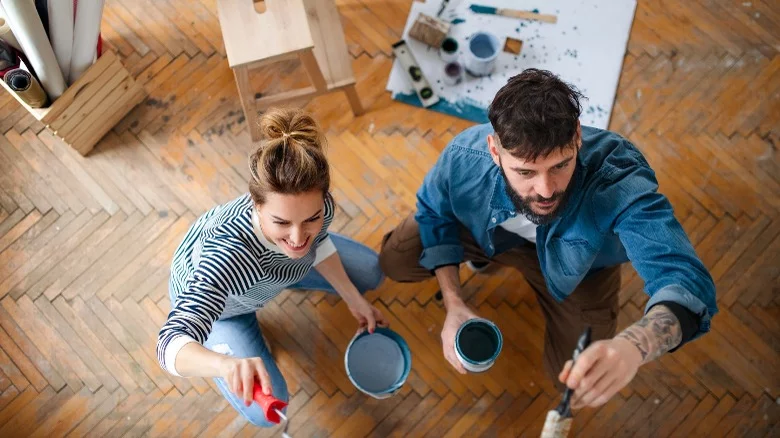
This first tip gives a big payback for little effort: painting an accent wall. It naturally draws the eye toward it and can brighten an entire room. And that's not all – Arizona Painting Company claims that a well-done accent wall can actually make a room look bigger than it is. This is good to know, especially if you want to make a small space appear roomier.
When considering accent wall colors, be careful with bold colors. UpNest prefers neutrals, but you'll still want the wall to be noticed. Try to use an accent wall color seen in other rooms to create a nice flow. For color suggestions, Designing Idea likes adding a dark gray accent wall next to a lighter gray one and also pairs dark blue with gray, or teal with white.
Which wall should you choose to be the accent wall? Realtor.com suggests walking into the room and noticing what your eye is drawn to first. So if your primary bedroom's focal point is the bed, you might want to paint the wall behind it. Avoid bold statement colors like red and stick with more muted tones. You can always start with something on the neutral side and go a little darker afterward.
Upgrade your curtains
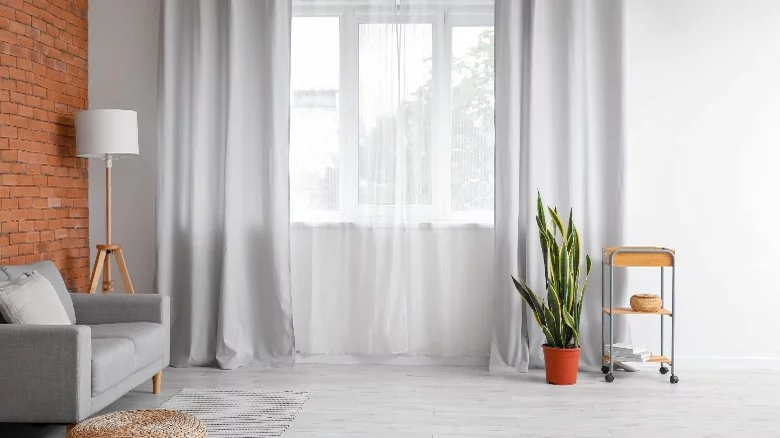
Old, heavy curtains gathering dust do little to add to your home's appeal and can make the décor look out of style. Contemporary curtains made from lighter materials open rooms and let the sunshine in, providing a welcoming backdrop for those who visit. The way they are hung also makes a difference, as explained by Joss & Main. The hardware can be adjusted if your existing curtains are in good shape and style. When curtain rods are placed higher, it makes the wall seem taller; just make sure that the bottoms are close enough to the ground. You can also extend the lengths of the rods to allow the curtains to open up fully. And when shopping for new hardware, look for interesting ones to replace old, dated pieces. Remember to repair any holes in the wall made during this project, too.
To let in even more light, swap out the old, heavy curtains with sheer panels. Not only are they lighter, but the rest of the room will also become brighter and more appealing. Cafe curtains can be made with sheer materials, and look lovely in kitchens and bathrooms. You can also replace older curtains with valances and panels.
Add some new area rugs
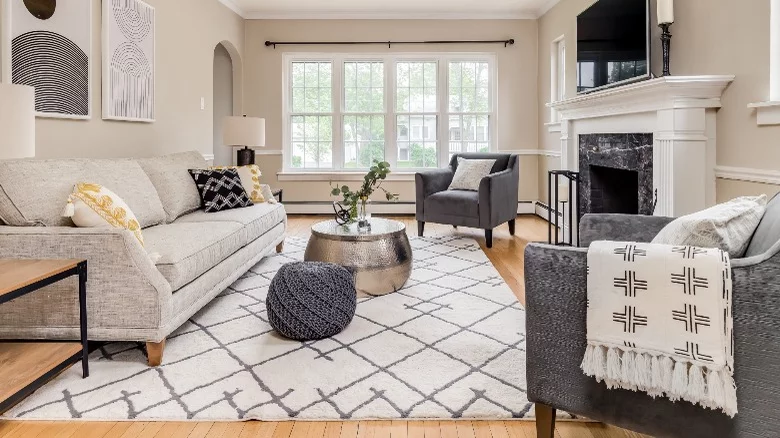
Fresh area rugs can add softness and color to your floors, and you can find inexpensive ones in an endless variety of sizes, shapes, and colors. Hommes Studio adds that area rugs make rooms seem cozier because they add warmth and texture. A well-chosen one brings together the room's other elements. For example, you might have a couch and chair that don't quite go together, but an area rug with colors from both can provide a more cohesive look — as long as it complements the two styles.
Virtually Staging Properties recommends measuring the space before buying an area rug, adding that a few feet of space around the borders looks best. Look for trending patterns, but as with the paint, don't go too bold. High-quality area rugs can be expensive, so don't invest a lot of money unless you're planning to take them with you. And when shopping for area rugs, don't forget to buy a rug pad to put underneath them. As Houzz points out, these pads are an important safety measure because they prevent people from slipping and falling. Without a rug pad, an area rug will move around or bunch up, especially on slippery, well-trafficked floors.
Change out loud wallpaper
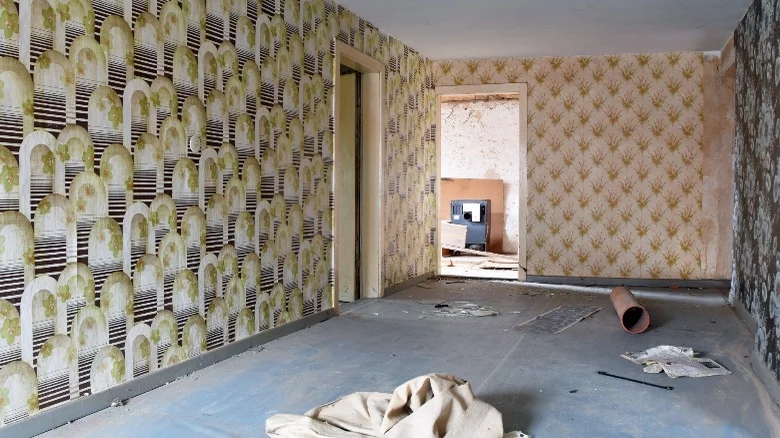
Wallpaper can make or break a room, and people can be very particular about what they like or dislike. A buyer might not even want to consider a fully-wallpapered home, especially if the patterns are loud, outdated, or both. Pittsburgh Staged Homes explains that wallpaper is a very personal choice, so the chances of all of your potential buyers liking what you have up are low. And besides that, educated homebuyers (and their real estate agents) know how difficult it is to take it down. Matthews' Painting Company claims that old wallpaper can sometimes be painted over, but only after the wallpaper has been repaired. If there are loose spots, reattach them with wallpaper adhesive and when that is finished, caulk the entire perimeter, apply oil-based primer, and paint.
Another possibility is putting up neutral peel-and-stick wallpaper over any existing busy patterns, but Limitless Walls reports that this will not work on damaged and vinyl wallpaper. If you're unsure about this, order a sample and see if it adheres to the surface (and stays on). Walls by Me explains that this kind of wallpaper has an adhesive backing, and since it's easier to install, you'll save a lot of time and effort. Just be sure not to buy any loud patterns, or those potential buyers will provide plenty of poor feedback.
Repair and paint your front door
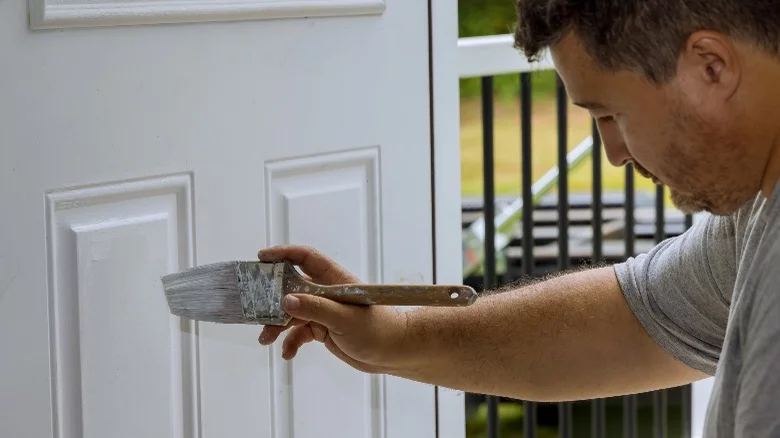
After the sidewalk, driveway, and landscaping, people notice front entrances as they approach homes. Yours might be fine structurally, but if it is not, it might be best to replace it with a new one. According to U.S. News, the signs of needed door replacement include moisture damage, looseness, drafts, and problems opening and closing it. Angi claims that homeowners can save money by replacing doors themselves, but it can involve choosing a new door frame and making wall repairs. The cost depends on the materials, labor, and whether it is a single- or double-door entry. To save money, you can complete minor repairs and paint it.
Simple door repairs like cracks can be addressed with wood filler, epoxy, sandpaper, a putty knife, and a Dremel tool (via WCMA NET Window & Door). Small cracks get filled in, and after they dry, you can sand down the area. Larger ones might need epoxy glue or wood splines. For the latter, you'll need to clean out the damage with a Dremel tool and place the spline over the crack. After the repairs, clean and degrease the door and allow it to dry. For wood doors, Ace Hardware uses exterior paint with a built-in primer to save the extra step. Use a small, angled paintbrush to cut the areas near the knob and any windows, and use a roller brush for the rest. You probably know what we're going to say next: Don't paint the door in a bright, bold color.
The power of decorative flowers
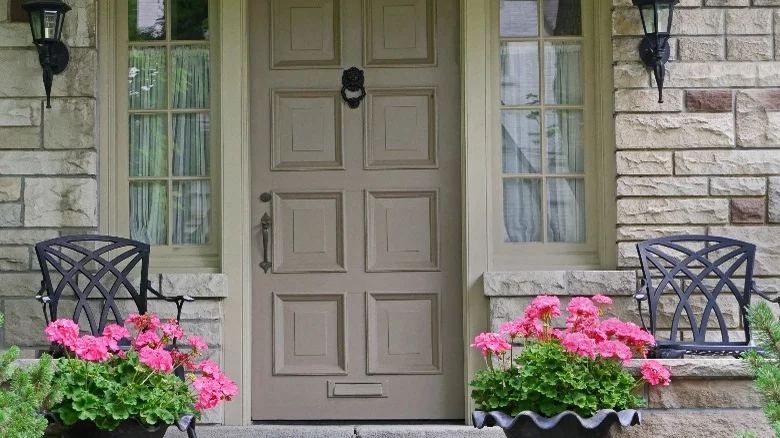
Flowers can spruce up the inside and outside of a home, as long as they are well-maintained and do not smell overly strong. If you have a front porch, Homestead Gardens recommends placing flower pots to add color. Be sure that the pots are not a tripping hazard, though. And depending on the time of year, you can also plant annuals or perennials to liven up your landscaping. Fresh, seasonal flowers also look lovely indoors, but designer Sophie Allport points out that silk ones require less care, last forever, and won't make people sneeze. To keep them looking good, Afloral recommends dusting them once in a while with a feather duster, a small clean paintbrush, or a fragrance-free wipe.
No Vacancy Home Staging discourages using artificial flowers, though, stating that fresher is better when staging a home. You can decorate with fresh flowers according to the season, too. A vase of bright tulips will look welcoming in the springtime, while holly and other seasonal natural decor are perfect for the wintertime. Larger, colorful displays look nice on dining room tables, and single-bud vases can be set on bedside tables. For the rest of your house, try cacti, orchids, and other low-maintenance houseplants.
Repair moldy walls
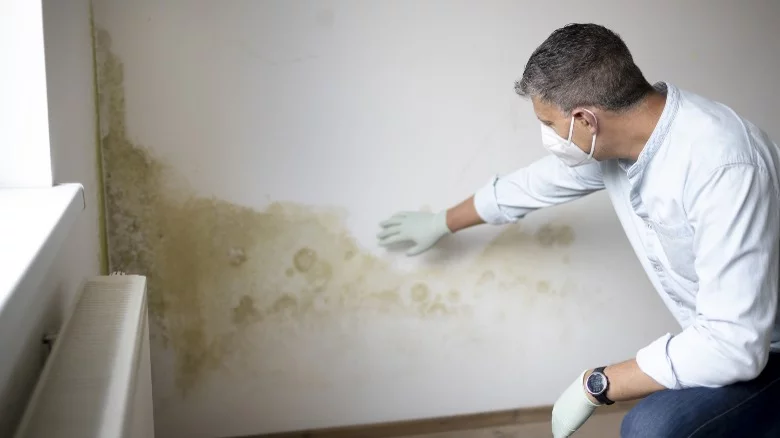
Mold, water stains, holes, and cracks in walls can detract from your home's appearance and can damage your home when not removed, as per Mold Answers. It can also make your home look old and unkempt and be a real buyer turn-off. You may be able to remove the mold yourself, but if the damage is extensive, you might want to contact a professional. Don't ignore the problem, as mold can also become a health hazard.
True Value emphasizes the importance of finding the source of the mold, which could be a leaky shower faucet or something more severe like roof damage. To remove mold, put on gloves and a mask and scrub at the stains with a bleach/water mixture. If you still see the marks afterward, cover them up with stain-blocking paint. Not only will this boost your home's appearance, but mold is often looked for during home inspections, so it's an issue that would have to be resolved down the line anyway.
Fixing unsightly grout damage
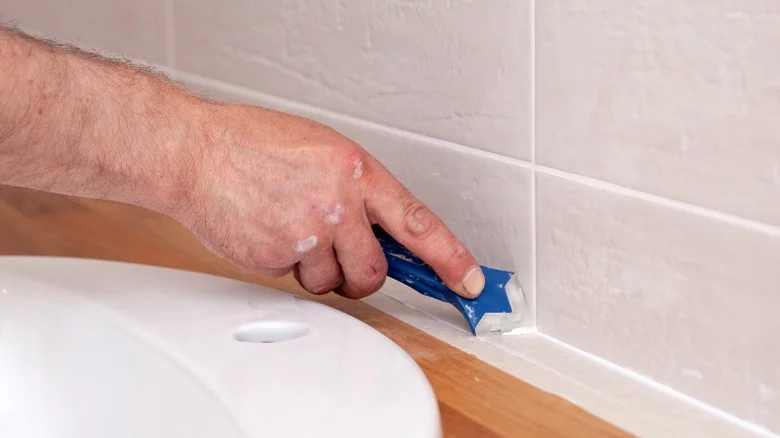
The grout that has lived between your shower tiles for many years has likely succumbed to mold, but that can be removed as described above. Once those stains are gone, you might be unpleasantly surprised to see cracks and small holes in the grout. According to BuildDirect, you'll want to remove the damaged grout with a grout saw and wear gloves and goggles while working. You can fill the cracks with caulk and smooth things out with dampened fingertips. Give this about two days to dry before using the area.
Cracked grout can be replaced with new grout, and like the caulk you choose, it should match what is already there. Sanded grout has a rougher texture, so don't use it on delicate materials like marble that are prone to scratching. You'll need to loosen and vacuum the existing grout first, then apply the new one with a grout float. Wait five minutes, and remove the excess with a damp cloth or sponge. After you buff your work to a shine, you might want to apply a grout sealant to preserve the finish.
Fluff out carpet dents
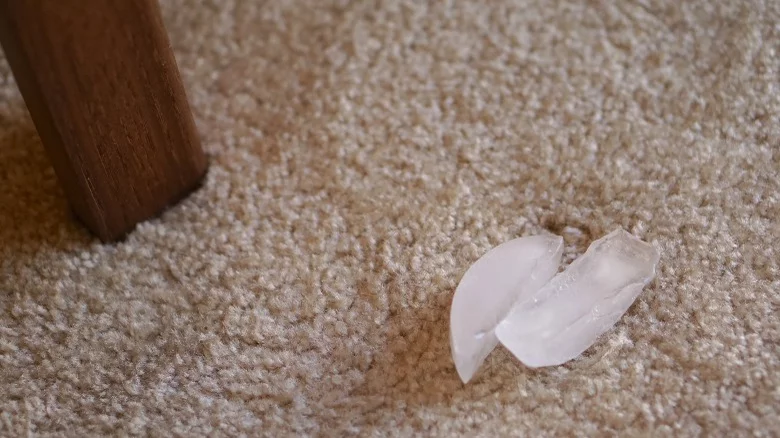
If you've ever rearranged furniture, you are probably familiar with carpet dents. Loudoun Valley Floors explains that heavy tables, beds, and other pieces compress rug and carpet fibers over time, leaving marks that buyers might notice. The dents are not always permanent, but if that dresser hasn't been moved for decades, you might have a heck of a time removing those marks. There are a few ways to do this, and none are that time-consuming.
Sams Carpet Services recommends loosening the dented fibers by hand and then using a hose attachment to vacuum the area. This is probably the least invasive method, but it will not always work. The second method uses heat, specifically, a hairdryer. To try this, spray the dent with water and plug in the dryer. Hold it about 6 inches away, and turn it on its highest setting. Hold it with one hand and work on the fibers with the other as you dry the area.
XL Cleaners uses steam to remove dents from rugs and carpets made from natural materials like cotton and wool. This source holds a hot iron about 6 inches above the dent and steams the area until it is wet. This can be dried with a towel. Another option is to first place the towel on top of the indentation and iron it. For synthetic fibers, just place ice cubes inside the dents and let them melt overnight. Dry with clean towels, and fluff things up with a fork or sturdy brush.
Add crown molding
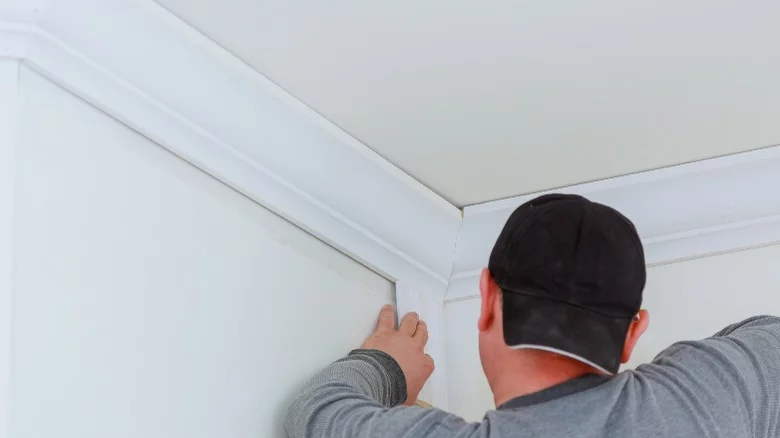
According to The Grit and Polish, flat crown molding is the easiest to install because the backs are smoother. And aside from that, you'll also need a hammer, caulk, a level, a cordless finish nailer, a compound miter saw, paint, and a paintbrush. To install, start in a corner and place it an ½ inch down from the ceiling to account for any unevenness on the top. Once the molding is installed, you can fill in any holes with the caulk.
Rehang your artwork

No one wants to look at crooked artwork or notice that it's hung at the wrong height — it looks messy or a little bit off. Thriving Home has a clever hack that will help you align your frames using painter's tape and a level. With the artwork facing down, stretch out a piece of painter's tape along the top, past the bracket(s). Then, use a marker to show where the nails need to be placed. Remove the tape and stick it on the wall where the frame needs to be hung. Use a level to ensure it is nice and straight, and make any needed adjustments. Drive in the nails through the tape, remove it, and rehang the frames.
As for the correct height, Studio McGee recommends hanging artwork at eye level. No one wants to stretch or bend their knees to get a good view. As a general rule, about 60 inches from the floor is good, but you'll need to adjust that if you have furniture beneath the artwork. It shouldn't be more than 6 inches above that.
The final piece of advice for wall decorations is to remove personal family photos. StandOut Home Staging & Design feels that these are distracting for buyers because they are personal. It's also a good idea to pack away trophies, religious artifacts, or avant-garde artwork.
Fixing scratched floors
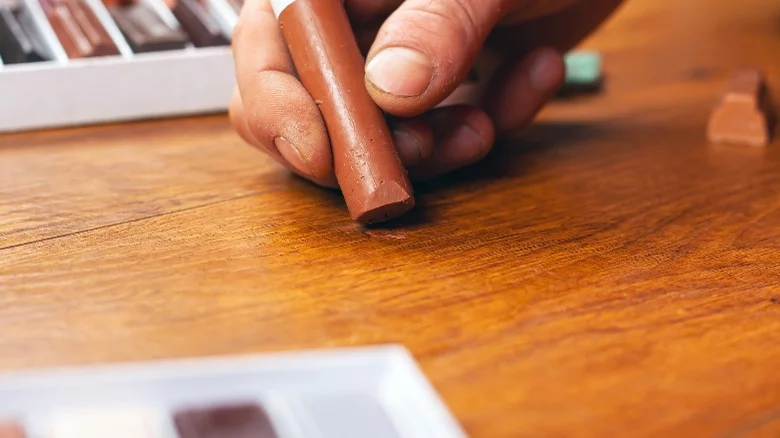
It is best to repair floor scratches last after the furniture has been moved and other fixes have been completed; those projects can cause additional marks. Classic Wood Floors shares an easy hack for minor hardwood floor surface scratches that shouldn't take more than a few minutes. Simply use a wood stain pen or permanent marker to fill them in, but choose a matching color and test in an inconspicuous area first. Deeper scratches must be sanded down and restained.
Home Flooring Pros repairs minor laminate floor scratches with matching wax pencils and buffs them out with clean, soft cloths. For larger scratches, get color-matched floor putty and spread it with a putty knife. If these do not work and the damage is noticeable, the floorboard might need to be replaced.
Horizon Carpet, Upholstery, Tile & Grout Cleaners recommends using brass polish to fix ceramic tile scratches, using a circular motion until the marks are gone. You can also polish the area with car wax when finished.
Source: housedigest.com













